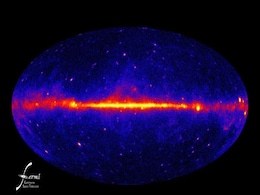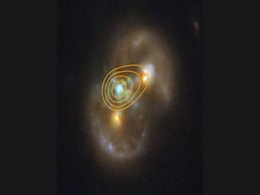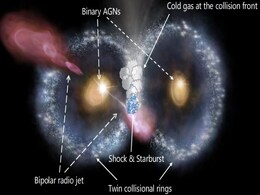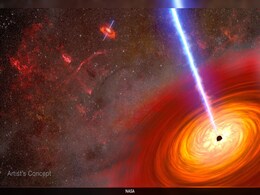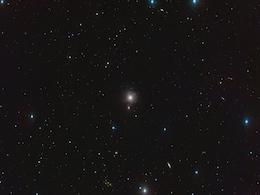Galaxy Collision
- All
- News
- Web Stories
-

Study Reveals The Mystery Behind Giant Radio Relics In The Universe
- Monday November 24, 2025
- Science | Edited by Astitva Raj
Based on these initial findings, the team further developed extremely high-resolution simulations called "shock-tubes."
-
 www.ndtv.com
www.ndtv.com
-

Flattened Dark Matter May Explain Mysterious Gamma-Ray Glow at Milky Way’s Core, Study Finds
- Sunday October 26, 2025
- Written by Gadgets 360 Staff
Dark matter near the Milky Way’s center appears flattened, not spherical, according to new simulations. The discovery may explain a puzzling gamma-ray glow long observed by NASA’s Fermi telescope, reigniting theories that dark matter collisions produce high-energy radiation in the galaxy’s core
-
 www.gadgets360.com
www.gadgets360.com
-

JWST Finds Black Hole Between Galaxy Cores, Hinting at Rare Direct Collapse Birth
- Thursday July 17, 2025
- Written by Gadgets 360 Staff
Using JWST, astronomers discovered a black hole between two galaxy cores in the Infinity Galaxy—possibly the first direct evidence of a black hole formed by gas collapse, not stellar death. This rare “heavy seed” black hole challenges standard models and could help explain how supermassive black holes appeared so soon after the Big Bang.
-
 www.gadgets360.com
www.gadgets360.com
-

James Webb Telescope Spots Rare ‘Cosmic Owl’ Formed by Colliding Galaxies
- Monday July 14, 2025
- Written by Gadgets 360 Staff
NASA’s James Webb Space Telescope has unveiled the “Cosmic Owl,” a jaw-dropping image of two colliding ring galaxies forming a structure that resembles an owl’s face. This double-ring formation is extraordinarily rare, and the event is shedding light on galaxy evolution, black hole dynamics, and rapid star formation. Led by Ph.D. student Mi...
-
 www.gadgets360.com
www.gadgets360.com
-

Most Distant Mini-Halo Discovered in Galaxy Cluster 10 Billion Light-Years Away
- Monday June 30, 2025
- Written by Gadgets 360 Staff
Astronomers have uncovered the most distant mini-halo ever detected, located around the galaxy cluster SpARCS1049, a staggering 10 billion light-years from Earth. Using the LOFAR radio telescope network, which spans eight European countries, researchers detected a faint, diffuse glow—evidence of a giant cloud of high-energy particles and magnetic...
-
 www.gadgets360.com
www.gadgets360.com
-

Two Galaxy Clusters That Collided Previously Are All Set To Smash Again
- Saturday June 7, 2025
- Science | Edited by Abhinav Singh
Despite their enormous distance, the galaxy clusters are gravitationally bound and slowly turning back for another high-speed impact.
-
 www.ndtv.com
www.ndtv.com
-

Milky Way To Collide With Its Largest Neighbour Andromeda? What New Study Said
- Tuesday June 3, 2025
- World News | Edited by NDTV News Desk
Earlier, scientists believed the collision may destroy both galaxies, merging them into an elongated one.
-
 www.ndtv.com
www.ndtv.com
-

Milky Way May Not Be Destroyed In Galactic Smash-Up After All
- Monday June 2, 2025
- Science | Agence France-Presse
The Milky Way may not have a catastrophic collision with another huge galaxy as has been predicted, computer simulations revealed, giving our home galaxy a coin-flip chance of avoiding destruction.
-
 www.ndtv.com
www.ndtv.com
-

When Two Massive Black Holes Merged And Went Flying Across Cosmos
- Sunday March 9, 2025
- Science | Edited by Anjali Thakur
The researchers propose that this ejection resulted from the collision of two galaxies, causing their central black holes to merge into a larger one.
-
 www.ndtv.com
www.ndtv.com
-

Astronomers Spot Galaxy NGC 3640 With a Past of Consuming Smaller Galaxies
- Tuesday February 25, 2025
- Written by Gadgets 360 Staff
Recent observations of NGC 3640 reveal a history of merging with smaller galaxies. Located 88 million light-years away, the elliptical galaxy is suspected to be on a collision course with NGC 3641. The Very Large Telescope captured structural distortions, hinting at previous mergers. Researchers have identified ancient stars acting as fossil marker...
-
 www.gadgets360.com
www.gadgets360.com
-

Strange Fast Radio Bursts Emerge from an Ancient Dead Galaxy, Baffling Scientists
- Monday February 24, 2025
- Written by Gadgets 360 Staff
Scientists have detected mysterious fast radio bursts (FRBs) from the outskirts of an 11 billion-year-old dead galaxy. This discovery challenges the belief that FRBs primarily originate from young, star-forming galaxies. Researchers suspect the bursts may result from colliding stars or a collapsing white dwarf. The Canadian Hydrogen Intensity Mappi...
-
 www.gadgets360.com
www.gadgets360.com
-

NASA's Hubble and Chandra Telescopes Spot Strange Tilted Black Hole
- Tuesday December 24, 2024
- Written by Gadgets 360 Staff
NASA’s Hubble and Chandra telescopes have uncovered a bizarre sideways black hole in the galaxy NGC 5084, located 80 million light-years away. The black hole’s unexpected tilt suggests it may have been influenced by a violent galactic collision. A new image processing technique, SAUNAS, revealed X-ray plumes in the galaxy, hinting at a cosmic e...
-
 www.gadgets360.com
www.gadgets360.com
-

Hubble and Chandra Telescopes Spot Strange Tilted Black Hole in Galaxy NGC 5084
- Tuesday December 24, 2024
- Written by Gadgets 360 Staff
NASA’s Hubble and Chandra telescopes have uncovered a bizarre sideways black hole in the galaxy NGC 5084, located 80 million light-years away. The black hole’s unexpected tilt suggests it may have been influenced by a violent galactic collision. A new image processing technique, SAUNAS, revealed X-ray plumes in the galaxy, hinting at a cosmic e...
-
 www.gadgets360.com
www.gadgets360.com
-

Ancient Galaxy Collisions May Explain Formation of Massive Early Star Systems
- Monday December 9, 2024
- Written by Gadgets 360 Staff
Research published in Nature reveals that ancient galaxy collisions may have led to the creation of the universe’s largest star systems. Using data from the Atacama Large Millimeter/submillimeter Array (ALMA), scientists studied over 100 galaxies undergoing intense star formation. These collisions are believed to have occurred 8 to 12 billion yea...
-
 www.gadgets360.com
www.gadgets360.com
-

Study Reveals The Mystery Behind Giant Radio Relics In The Universe
- Monday November 24, 2025
- Science | Edited by Astitva Raj
Based on these initial findings, the team further developed extremely high-resolution simulations called "shock-tubes."
-
 www.ndtv.com
www.ndtv.com
-

Flattened Dark Matter May Explain Mysterious Gamma-Ray Glow at Milky Way’s Core, Study Finds
- Sunday October 26, 2025
- Written by Gadgets 360 Staff
Dark matter near the Milky Way’s center appears flattened, not spherical, according to new simulations. The discovery may explain a puzzling gamma-ray glow long observed by NASA’s Fermi telescope, reigniting theories that dark matter collisions produce high-energy radiation in the galaxy’s core
-
 www.gadgets360.com
www.gadgets360.com
-

JWST Finds Black Hole Between Galaxy Cores, Hinting at Rare Direct Collapse Birth
- Thursday July 17, 2025
- Written by Gadgets 360 Staff
Using JWST, astronomers discovered a black hole between two galaxy cores in the Infinity Galaxy—possibly the first direct evidence of a black hole formed by gas collapse, not stellar death. This rare “heavy seed” black hole challenges standard models and could help explain how supermassive black holes appeared so soon after the Big Bang.
-
 www.gadgets360.com
www.gadgets360.com
-

James Webb Telescope Spots Rare ‘Cosmic Owl’ Formed by Colliding Galaxies
- Monday July 14, 2025
- Written by Gadgets 360 Staff
NASA’s James Webb Space Telescope has unveiled the “Cosmic Owl,” a jaw-dropping image of two colliding ring galaxies forming a structure that resembles an owl’s face. This double-ring formation is extraordinarily rare, and the event is shedding light on galaxy evolution, black hole dynamics, and rapid star formation. Led by Ph.D. student Mi...
-
 www.gadgets360.com
www.gadgets360.com
-

Most Distant Mini-Halo Discovered in Galaxy Cluster 10 Billion Light-Years Away
- Monday June 30, 2025
- Written by Gadgets 360 Staff
Astronomers have uncovered the most distant mini-halo ever detected, located around the galaxy cluster SpARCS1049, a staggering 10 billion light-years from Earth. Using the LOFAR radio telescope network, which spans eight European countries, researchers detected a faint, diffuse glow—evidence of a giant cloud of high-energy particles and magnetic...
-
 www.gadgets360.com
www.gadgets360.com
-

Two Galaxy Clusters That Collided Previously Are All Set To Smash Again
- Saturday June 7, 2025
- Science | Edited by Abhinav Singh
Despite their enormous distance, the galaxy clusters are gravitationally bound and slowly turning back for another high-speed impact.
-
 www.ndtv.com
www.ndtv.com
-

Milky Way To Collide With Its Largest Neighbour Andromeda? What New Study Said
- Tuesday June 3, 2025
- World News | Edited by NDTV News Desk
Earlier, scientists believed the collision may destroy both galaxies, merging them into an elongated one.
-
 www.ndtv.com
www.ndtv.com
-

Milky Way May Not Be Destroyed In Galactic Smash-Up After All
- Monday June 2, 2025
- Science | Agence France-Presse
The Milky Way may not have a catastrophic collision with another huge galaxy as has been predicted, computer simulations revealed, giving our home galaxy a coin-flip chance of avoiding destruction.
-
 www.ndtv.com
www.ndtv.com
-

When Two Massive Black Holes Merged And Went Flying Across Cosmos
- Sunday March 9, 2025
- Science | Edited by Anjali Thakur
The researchers propose that this ejection resulted from the collision of two galaxies, causing their central black holes to merge into a larger one.
-
 www.ndtv.com
www.ndtv.com
-

Astronomers Spot Galaxy NGC 3640 With a Past of Consuming Smaller Galaxies
- Tuesday February 25, 2025
- Written by Gadgets 360 Staff
Recent observations of NGC 3640 reveal a history of merging with smaller galaxies. Located 88 million light-years away, the elliptical galaxy is suspected to be on a collision course with NGC 3641. The Very Large Telescope captured structural distortions, hinting at previous mergers. Researchers have identified ancient stars acting as fossil marker...
-
 www.gadgets360.com
www.gadgets360.com
-

Strange Fast Radio Bursts Emerge from an Ancient Dead Galaxy, Baffling Scientists
- Monday February 24, 2025
- Written by Gadgets 360 Staff
Scientists have detected mysterious fast radio bursts (FRBs) from the outskirts of an 11 billion-year-old dead galaxy. This discovery challenges the belief that FRBs primarily originate from young, star-forming galaxies. Researchers suspect the bursts may result from colliding stars or a collapsing white dwarf. The Canadian Hydrogen Intensity Mappi...
-
 www.gadgets360.com
www.gadgets360.com
-

NASA's Hubble and Chandra Telescopes Spot Strange Tilted Black Hole
- Tuesday December 24, 2024
- Written by Gadgets 360 Staff
NASA’s Hubble and Chandra telescopes have uncovered a bizarre sideways black hole in the galaxy NGC 5084, located 80 million light-years away. The black hole’s unexpected tilt suggests it may have been influenced by a violent galactic collision. A new image processing technique, SAUNAS, revealed X-ray plumes in the galaxy, hinting at a cosmic e...
-
 www.gadgets360.com
www.gadgets360.com
-

Hubble and Chandra Telescopes Spot Strange Tilted Black Hole in Galaxy NGC 5084
- Tuesday December 24, 2024
- Written by Gadgets 360 Staff
NASA’s Hubble and Chandra telescopes have uncovered a bizarre sideways black hole in the galaxy NGC 5084, located 80 million light-years away. The black hole’s unexpected tilt suggests it may have been influenced by a violent galactic collision. A new image processing technique, SAUNAS, revealed X-ray plumes in the galaxy, hinting at a cosmic e...
-
 www.gadgets360.com
www.gadgets360.com
-

Ancient Galaxy Collisions May Explain Formation of Massive Early Star Systems
- Monday December 9, 2024
- Written by Gadgets 360 Staff
Research published in Nature reveals that ancient galaxy collisions may have led to the creation of the universe’s largest star systems. Using data from the Atacama Large Millimeter/submillimeter Array (ALMA), scientists studied over 100 galaxies undergoing intense star formation. These collisions are believed to have occurred 8 to 12 billion yea...
-
 www.gadgets360.com
www.gadgets360.com


